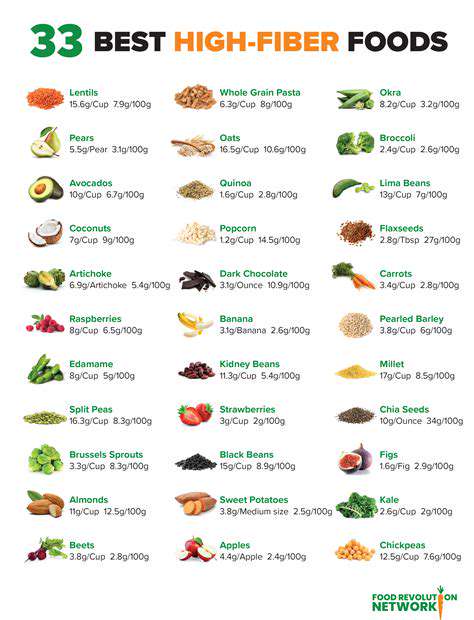High Fiber Diet Benefits: Recipes for Digestive Health
Understanding the Importance of Fiber
Adopting a high-fiber eating pattern goes beyond simply preparing tasty meals; it represents a conscious commitment to improved health and vitality. This often-overlooked nutrient serves multiple critical functions in the body. Dietary fiber acts as nature's broom, sweeping through our digestive tract to promote regularity and prevent common gastrointestinal complaints. It creates a satisfying feeling of fullness that naturally helps control appetite, while simultaneously moderating how quickly sugars enter our bloodstream. Perhaps most importantly, fiber serves as nourishment for our gut microbiota, fostering a diverse community of beneficial bacteria that influence everything from immunity to mood regulation.
The fiber family includes two distinct members, each with unique benefits. Soluble varieties blend with water to form a gel that helps manage cholesterol and blood sugar levels. In contrast, insoluble types remain intact as they travel through our system, adding necessary bulk to support regular elimination. Achieving the right balance of both forms creates optimal conditions for digestive wellness.
Fiber-Rich Food Choices
Nature offers an abundant variety of fiber sources beyond the standard fruit and vegetable recommendations. Ancient grains like farro, freekeh, and amaranth provide hearty doses of fiber along with sustained energy. The legume family - including often-overlooked varieties like mung beans and black-eyed peas - delivers impressive amounts of this crucial nutrient alongside plant-based protein and essential micronutrients.
Small but mighty, seeds such as chia, flax, and hemp offer concentrated fiber along with beneficial fats. When selecting produce, consider texture as an indicator of fiber content - crisp apples with their skins, slightly underripe bananas, and al dente vegetables typically provide more roughage. Diversifying your fiber sources ensures you receive the full spectrum of health benefits while keeping meals interesting.
Planning Your High-Fiber Meals
Transitioning to fiber-rich eating requires strategy rather than drastic change. Begin with simple substitutions - choose pearled barley instead of white pasta, or mix riced cauliflower with whole grain couscous. Morning meals present prime opportunities; consider overnight oats with flaxseed or a vegetable-packed frittata with whole grain toast. The key lies in progressive adaptation, allowing your digestive system time to adjust to increased fiber loads. This measured approach helps minimize potential discomfort while establishing sustainable habits.
Making Fiber a Habit
Long-term success with high-fiber eating hinges on consistency and patience. View fiber increase as a gradual process rather than an overnight transformation. Proper hydration plays a critical supporting role - water acts as fiber's partner, helping it move smoothly through your system. Pay attention to your body's signals, adjusting both fiber quantities and water intake accordingly. Finding your personal balance between fiber consumption and fluid intake creates the foundation for comfortable, lasting change.
Addressing Potential Side Effects
Initial encounters with increased fiber might include temporary digestive adjustments as your system adapts. These typically mild symptoms often resolve within weeks as your microbiome recalibrates. Implement changes incrementally, allowing each adjustment period before adding more. Remember that hydration remains essential - water helps fiber perform its functions without causing congestion. Should discomfort persist beyond the expected adjustment period, professional guidance can help identify potential sensitivities or underlying conditions.
Beyond the Plate: Lifestyle Considerations
A truly fiber-centric lifestyle incorporates complementary wellness practices. Regular movement, whether through structured exercise or increased daily activity, synergizes with fiber's digestive benefits. Mindfulness practices can optimize gut-brain communication, while quality sleep supports the body's natural detoxification and repair cycles. This holistic approach amplifies fiber's positive impacts, influencing everything from metabolic efficiency to cognitive function. The cumulative effect extends far beyond regularity, potentially enhancing multiple aspects of health and well-being.

- Healthy Meal Prep for Weight Loss: 5 Days of Deliciousness
- Smart Food Storage: Keep Your Groceries Fresh Longer
- Storing Rice and Grains: Pantry Best Practices
- Pantry Organization Hacks: Declutter Your Kitchen
- Low Carb Dinners: Keto Friendly Options
- Baking with Alternative Flours: Gluten Free and Beyond
- Keto Desserts: Guilt Free Sweet Treats
- Buying Organic Produce: Is It Worth the Cost?
- Fluffy Pancakes from Scratch: Your New Weekend Ritual
- Healthy Breakfast Smoothies: Power Packed Blends
- Quick & Easy Stir Fries: Healthy and Delicious
- Understanding Food Labels: What to Look For and Avoid